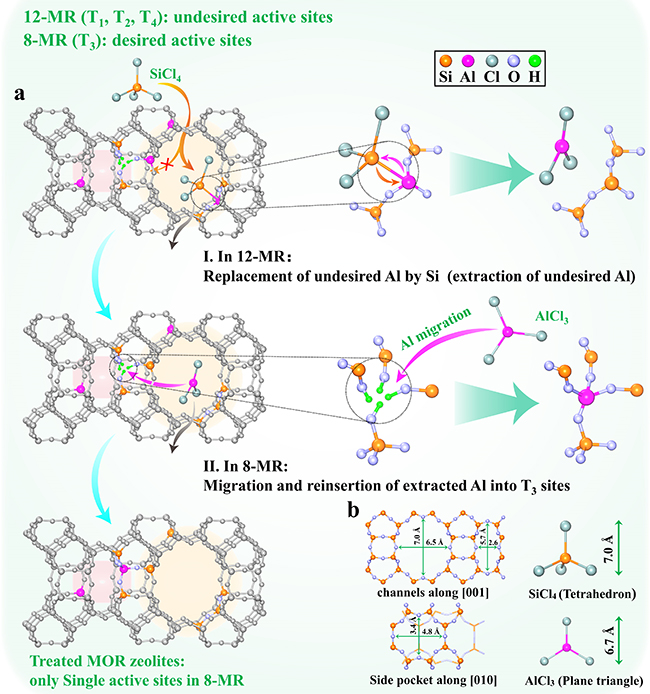Zeolites are widely used in adsorption separation, ion exchange, and heterogeneous catalysis.
The site of acidity-related aluminum atoms in the zeolite framework is critical for the physicochemical performances of the zeolite.
Recently, a research team led by Profs. LIU Zhongmin from the Dalian Institute of Chemical Physics (DICP) of the Chinese Academy of Sciences (CAS) developed a new strategy to control the site of Al atoms in zeolite framework.
This study was published in Angewandte Chemie International Edition on Feb. 22.

a) Sketch map of a typical treatment process, showing the directional migration of framework Al into T3 sites of the MOR zeolite via LPST; b) The topology of MOR and the steric configuration of SiCl4and AlCl3 molecules with a kinetic diameter of 7.0 and 6.7 ?, respectively (Image by LIU Rongsheng)
In the strategy, the researchers relocated mordenite (MOR) framework Al atoms into the desired T3 sites by low-pressure SiCl4 treatment (LPST). The prepared MOR catalysts showed good catalytic performance in dimethyl ether carbonylation to methyl acetate reaction.
Furthermore, they investigated the change of framework compositions for the samples before and after LPST. They found that there were three stages during the treated reaction: Al extraction stage, Al migration stage and Al Insertion stage.
In Al extraction stage, due to the restriction of molecular size, SiCl4 could selectively access 12-membered ring (MR) rather than 8-MR channels. As SiCl4 molecules diffused into the 12-MR, they preferentially reacted with the framework Al in 12-MR with the release of AlCl3. That is to say, the undesired framework Al was extracted as a form of AlCl3 via replacing by Si.
As for Al migration stage, the AlCl3 molecule, which was more easily distorted owing to its plane triangle configuration, could migrate into 8-MR channels through the side pockets.
In Al Insertion stage, the AlCl3 could react with silanol defects of 8-MR channels to insert Al into T3 sites as tetrahedrally coordinated species.
Moreover, they used high-field 27Al nuclear magnetic resonance to identify the exact location of framework Al for the MOR samples. The results indicated that 73% of the framework Al atoms were at the T3 sites after LPST under optimal conditions, forming reactively favorable active sites (about 90%) in 8-MR channels. Therefore, it could controllably generate and intensify active sites in MOR zeolite for dimethyl ether (DME) carbonylation reaction with higher methyl acetate (MA) selectivity and much longer lifetime.
"This work puts forward a facile strategy for directionally relocating framework Al among the different T-sites of the MOR zeolite and potentially applicating it in other zeolites to control Al location," said Prof. LIU.
This work was supported by the National Natural Science Foundation of China, the International Partnership Program of CAS, the Key Research Program of Frontier Sciences of CAS. (Text by LIU Rongsheng)